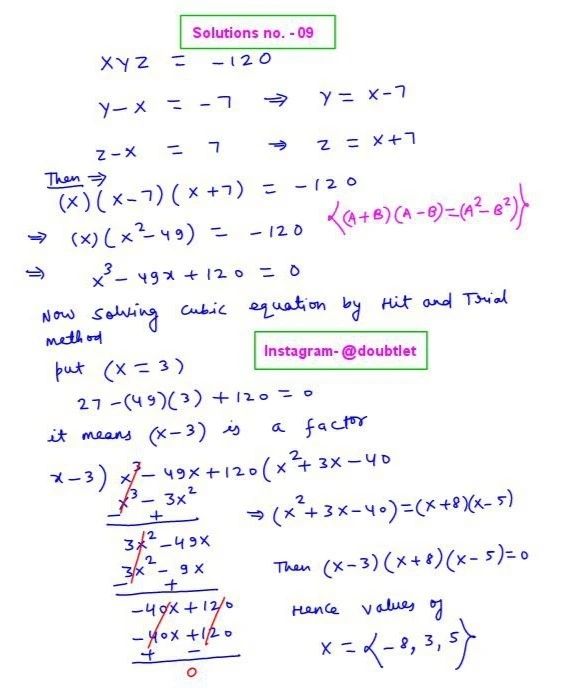









The matrix determinant is a scalar value calculated from a square matrix that provides insight into its properties, such as invertibility and the effect of linear transformations. A determinant of zero indicates that the matrix is singular and non-invertible, while a non-zero determinant means the matrix is invertible and can be used in solving linear systems.

Neetesh Kumar | September 10, 2024
Share this Page on:
![]()
![]()
![]()
![]()
![]()
- 1. Introduction to the Matrix Determinant
- 2. What is Matrix Determinant
- 3. How to find the Matrix Determinant
- 4. Rules for Matrix Determinant
- 5. Properties of Matrix Determinant
- 6. Matrix Determinant Solved Examples
- 7. Practice questions on Matrix Determinant
- 8. FAQs on Matrix Determinant
- 9. Real-life application of Matrix Determinant
- 10. Conclusion
1. Introduction to the Matrix Determinant:
The matrix determinant is a fundamental concept in linear algebra. It plays a crucial role in solving systems of linear equations, understanding matrix behavior, and in practical fields like physics, engineering, and computer science. Essentially, the determinant gives us important information about the matrix, including whether it is invertible or not, and how it scales and transforms spaces. In this guide, we’ll dive into the definition of the matrix determinant, how to calculate it, and its practical applications.
2. What is Matrix Determinant:
A matrix determinant is a scalar value that can be calculated from a square matrix (a matrix with the same number of rows and columns). This value is vital for understanding matrix properties like invertibility. The determinant can tell us if the matrix has an inverse (non-zero determinant), or if it's singular (zero determinant). In geometric terms, the determinant of a matrix corresponds to the scaling factor of the linear transformation the matrix represents. For a matrix, the determinant is calculated by a simple formula, but for larger matrices, the process becomes more complex.
For a matrix:
The determinant is calculated as:
3. How to Find the Matrix Determinant:
The method for calculating the determinant depends on the size of the matrix. Here's how to find it step by step for and larger matrices.
-
Matrix: The formula for the determinant of a matrix is straightforward:
-
Matrix: For a matrix, you need to use cofactor expansion, which involves breaking down the matrix into smaller matrices. For a matrix :
The determinant is:
- Larger Matrices: For larger matrices, you continue using cofactor expansion or use other techniques such as row reduction to simplify the matrix into an upper triangular form. This reduces the complexity of calculating determinants for matrices larger than .
4. Rules for Matrix Determinant:
When working with matrix determinants, several important rules can simplify your calculations:
-
Determinant of Identity Matrix: The determinant of the identity matrix is always 1, no matter its size.
-
Row Operations: We can apply any row operation to make the elements of that row zero.
-
Swapping Rows: Swapping two rows of a matrix changes the sign of the determinant.
-
Multiplying a Row by a Scalar: If a row is multiplied by a scalar , the determinant is multiplied by .
-
Adding a Multiple of One Row to Another: Adding a multiple of one row to another does not change the determinant.
-
Zero Determinant: If a matrix has a row or column of all zeros, its determinant is zero, meaning the matrix is singular (non-invertible).
5. Properties of Matrix Determinant:
Understanding the properties of the matrix determinant helps in simplifying calculations and understanding matrix behavior:
-
Multiplicative Property: The determinant of a product of two matrices is the product of their determinants:
-
Inverse Matrix: If a matrix is invertible, the determinant of its inverse is the reciprocal of the determinant of the original matrix:
-
Transpose Property: The determinant of a matrix is equal to the determinant of its transpose:
-
Eigenvalue Property: The determinant of a matrix is the product of its eigenvalues.
-
Block Matrix Determinants: For block diagonal matrices, the determinant is the product of the determinants of the blocks.
6. Matrix Determinant Solved Examples:
Question:1.
Determinant of a Matrix:
Solution:
Step 1: Identify the elements of the matrix:
Step 2: Apply the determinant formula:
Substitute the values of and :
7. Practice Questions on Matrix Determinant:
Q.1: Find the determinant of the following matrix:
Q.2: Calculate the determinant of this matrix:
8. FAQs on Matrix Determinant:
What is the matrix determinant?
The determinant of a matrix is a scalar value that is calculated from a square matrix. It provides important information about the matrix, such as whether it is invertible and how it affects space in geometric transformations.
Can all matrices have a determinant?
No, only square matrices (matrices with the same number of rows and columns) have a determinant. Non-square matrices do not have a determinant.
What does a determinant of zero mean?
If the determinant of a matrix is zero, the matrix is considered singular, meaning it is not invertible. A zero determinant indicates that the matrix collapses space into a lower dimension.
How is the determinant of a matrix calculated?
For a matrix , the determinant is calculated as:
What is the purpose of finding the determinant?
The determinant helps determine if a matrix is invertible, whether systems of linear equations have unique solutions, and how the matrix transforms space (e.g., scaling, rotating, or reflecting).
What happens if two rows (or columns) of a matrix are identical?
If two rows or columns of a matrix are identical, the determinant of that matrix will be zero, making the matrix singular and non-invertible.
Can the determinant be negative?
Yes, the determinant of a matrix can be positive, negative, or zero. A negative determinant indicates that the matrix involves a transformation that reverses orientation, like flipping or reflecting.
How is the determinant used in real-world applications?
The determinant is used in physics for solving systems of equations, calculating areas and volumes, and understanding linear transformations. In computer graphics, it helps manage transformations like scaling and rotation. It is also used in cryptography and engineering to solve complex systems of equations.
9. Real-Life Application of Matrix Determinant:
Matrix determinants are not just theoretical; they have practical applications in various fields:
-
Physics: Determinants are used to solve systems of linear equations in mechanics and thermodynamics. They also play a role in calculating areas, volumes, and other physical properties.
-
Computer Graphics: In 2D and 3D graphics, determinants help compute transformations like scaling, rotation, and shear. Determinants ensure these transformations are mathematically sound.
-
Engineering: Determinants are used in circuit analysis, structural analysis, and in solving differential equations that describe engineering systems.
-
Cryptography: Determinants are applied in algorithms that deal with encryption and decryption processes, especially when matrices are used in cryptographic keys.
10. Conclusion:
The matrix determinant is a powerful tool in linear algebra, providing valuable insights into matrix properties and their applications. Whether solving linear equations, determining if a matrix is invertible, or applying transformations in computer graphics and physics, understanding how to calculate and use determinants is essential. By mastering this concept, you’ll be better equipped to tackle more complex problems in mathematics and various real-world applications.
If you have any suggestions regarding the improvement of the content of this page, please write to me at My Official Email Address: [email protected]
Are you Stuck on homework, assignments, projects, quizzes, labs, midterms, or exams?
To get connected to our tutors in real-time. Sign up and get registered with us.
Matrix Determinant Calculator
Matrix Formula Sheet
Linear Algebra Calculators
Matrix Inverse Calculator
Matrix Scalar Multiplication Calculator
Blog Information
Blog Author: Neetesh Kumar
Blog Publisher: Doubtlet
Comments(0)
Your comment will be reviewed before it is published.



Leave a comment